AudioReputation is reader-supported. When you buy through links on our site, we may earn an affiliate commission Learn More
Looking for a surround sound amplifier for your 5.1 or 7.1 system? You’ve come to the right place. Our article about 8 best surround sound amplifiers for 5.1 & 7.1 systems in 2024 is here to make your search much easier. It will help you understand these devices better, give you some guidelines that can help you find exactly what you’re looking for, and finally, present to you our selection of 5.1 and 7.1 surround sound amplifiers.
Table of Contents
- What’s the Purpose of a Surround Sound Amplifier?
- Best Surround Sound Amplifiers – Comparison Table
- 8 Best Surround Sound Amplifiers for 5.1 & 7.1 Systems in 2024
- 8 Best Surround Sound Amplifiers for 5.1 Systems in 2024
- 1. Best 5.2 4K Surround Sound Amplifier Under $250 – Sony STR-DH590
- 2. Best 5.2 4K AV Receiver Under $500 – Denon AVR-S650H
- 3. Best 5.1 Surround Sound Amplifier Under $300 – Yamaha RX-V385
- 4. Most HDMI Connections – Marantz NR1403
- Best Surround Sound Amplifiers for 7.1 Systems in 2024
- 5. Most Versatile 7.2 Surround Sound Amplifier Under $600 – Denon AVR-S950H
- 6. Best 7.2 Surround Sound Amplifier Under $1,000 – Yamaha Aventage RX-A880
- 7. Best Chromecast-Enabled 7.2 AV Receiver – Sony STR-DN1080
- 8. The Slimmest 7.2 Surround Sound Amplifier – Marantz NR1710
- FAQs
- Q: What is better 5.1 or 7.1 surround sound?
- Q: What to pay attention to when looking for a surround sound amplifier for 5.1 & 7.1 systems?
- Q: Can you use a 7.1 receiver with a 5.1 speaker system?
- Q: What is the best surround sound amplifier for 5.1 & 7.1 Systems?
- Q: Is 7.1 better than Atmos?
- Q: What is the difference between 7.1 and 7.2 surround sound?
What’s the Purpose of a Surround Sound Amplifier?
For the purposes of our article about the best surround sound amplifiers, we considered surround sound amplifiers and AV receivers the same thing. However, it is important for you to understand that amplifiers and AV receivers are not absolutely the same. You see, every AV receiver is also a surround sound amplifier, but surround sound amplifiers are not AV receivers.
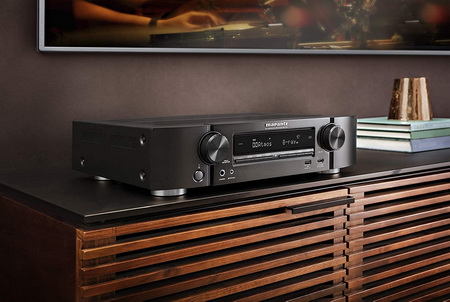
The purpose of a surround sound amplifier is much simpler – it is only supposed to amplify an incoming audio signal and send it to your home theater speaker system. AV receivers, on the other hand, are a bit busier. Like the amplifiers, they amplify the audio signals and send them to your home theater speakers, but they also have to receive all the analog and digital audio signals, as well as video signals, coming from all the sources connected to it. Then, they have to decode surround sound and stereo audio signals and send them to the amplifier section of an AV receiver. They also have to send the video signal to your TV or projector. An amplification is just one of the jobs done by an AV receiver, while it’s the only job of a surround sound amplifier.
So, why did we decide to use these two terms interchangeably? Well, because the number of available surround sound amplifiers is very limited. You have just a few available models at the moment (Monolith 5X, Yamaha Aventage MX-A5200BL, Outlaw Model 5000) and they all require another unit that does the rest of the job of an AV receiver (this unit is called surround sound processor or AV preamp). In general, separate units deliver better performance but they are also much more expensive and, as we’ve just said, they are quite rare. That’s why our article is actually about AV receivers.
Best Surround Sound Amplifiers – Comparison Table
| Surround Sound Amplifiers | Rating | Price | Review |
|---|---|---|---|
| Best Surround Sound Amplifiers for 5.1 Systems | |||
| Sony STR-DH590 | 4.4 | Check Amazon Check Walmart | Read Review |
| Denon AVR-S650H | 4.5 | Check Amazon Check Walmart | Read Review |
| Yamaha RX-V385 | 4.6 | Check Amazon Check Walmart | Read Review |
| Marantz NR1403 | 4.1 | Check Amazon | Read Review |
| Best Surround Sound Amplifiers for 7.1 Systems | |||
| Denon AVR-S950H | 4.3 | Check Amazon Check Walmart | Read Review |
| Yamaha Aventage RX-A880 | 4.5 | Check Amazon Check Walmart | Read Review |
| Sony STR-DN1080 | 4.2 | Check Amazon Check Walmart | Read Review |
| Marantz NR1710 | 4.6 | Check Amazon | Read Review |
As usual, we did our research, identified the most popular and highly-praised 5.1 and 7.1 AV receivers, put them all to the test, compared the results, and gathered our favorites. The following models are, in our opinion, 8 best surround sound amplifiers for 5.1 & 7.1 systems in 2024.
8 Best Surround Sound Amplifiers for 5.1 & 7.1 Systems in 2024
8 Best Surround Sound Amplifiers for 5.1 Systems in 2024
1. Best 5.2 4K Surround Sound Amplifier Under $250 – Sony STR-DH590
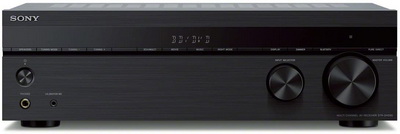
Sony STR-DH950 is a very affordable and great-performing 5.2 receiver with 4K pass-through. It supports some of the latest video standards and can drive moderately demanding 5.1/5.2 speaker systems. It lacks some advanced features but we can’t really consider that lack of versatility a downside, especially at this price point. STR-DH950 is our top choice under $250.
 Things we like
Things we like
STR-DH950 comes with a remote, FM antenna, and DCAC mic for the auto-calibration.
The unit is very user-friendly and easy to setup. When you connect all the speakers, you are supposed to use the mic and Sony’s DCAC auto-calibration tool to adjust the sound output to your room characteristics. To control the playback and audio/video parameters, you have to use the control panel or the remote.
Most of the inputs/outputs are on the back. On the front panel, there’s just a headphone OUT and mic IN (for calibration).
The rear panel houses 4 HDMI 2.0 IN and one HDMI ARC OUT. They all support 4K pass-through, they are compliant with the HDCP2.2. Also, they support HLG, HDR10, and Dolby Vision.
Apart from HDMI inputs, STR-DH950 has one TOSLINK input, one coax input, and 4 RCA analog audio inputs. The rear panel also houses an FM antenna connector and a USB power-out port.
The receiver has 5 amplified speaker terminals. Only two of those (front left and front right) support banana plugs, while the other 3 (center channel, surround left, surround right) accept only bare wires (spring clips). The unit also has two subwoofer pre-outputs (for connecting active subwoofers). STR-DH950 is compatible with 6-16Ω speakers. With two 6Ω channels driven, the unit will push 90W per channel (0.09% THD across the whole audible spectrum).
One of the special features of this receiver is the so-called S-Force PRO. When active, this feature will simulate surround sound even when only two speakers are connected. It won’t sound as good as true surround sound, but it will create a better sense of space.
When it comes to wireless connections, STR-DH950 features only Bluetooth 4.2. You can stream audio wirelessly from any Bluetooth source. The range and connection reliability are pretty great.
The unit supports DD 5.1, DD+, DD HD, DTS 5.1, DTS 96/24, DTS HD Master Audio, DSD, and PCM surround sound formats.
 Things we don’t like
Things we don’t like
Like I said in the introduction, this Sony receiver lacks wi-fi, multi-zone feature, phono inputs, and preamp outputs (aside from subwoofer pre-outputs), but you can’t expect all these features when the price is so low.
Also, the receiver can’t decode Dolby Atmos and DTS:X but that’s pretty much expected.
2. Best 5.2 4K AV Receiver Under $500 – Denon AVR-S650H
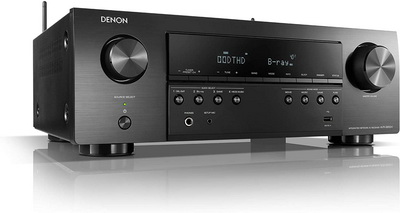
Denon AVR-S650H is a much more advanced and more versatile AV receiver than the previous Sony unit. It’s a quite feature-packed and very capable 5.2 receiver. Naturally, it’s also more expensive than the previous STR-DH590. AVR-S650H is our top suggestion under $500.
 Things we like
Things we like
AVR-S650H comes with a remote, AM/FM antennas, and AUDYSSEY MultiEQ mic for sound calibration.
During the initial installation, you just have to follow pretty simple on-screen instructions and calibrate the sound with the included mic. To control the playback and audio/video settings, you can either use the buttons on the control panel, the remote, or the Denon AVR remote app. The unit is quite user-friendly and easy to control.
AVR-S650H could easily be the most versatile receiver in its price range. On the front, there’s one headphone OUT, mic IN, and a USB port for music playback.
On the rear panel, you have 5 HDMI 2.0 IN and 1 HDMI eARC OUT. They are all HDCP2.3 compliant and support HLG, HDR10, and Dolby Vision. Naturally, all HDMI inputs support 4K/60p signal pass-through and 3D video.
Apart from HDMI connections, you have quite a few other inputs – there are two TOSLINK optical inputs, one coaxial audio IN, two composite video inputs and one composite output, two analog RCA audio inputs, and one phono input. Finally, you have an Ethernet port and AM/FM antenna connectors.
The rear panel houses 5 powered speaker terminals and two subwoofer pre-output ports for connecting active subwoofers. There are no preamp outputs for the other 5 channels. The receiver is compatible with 4-16Ω speakers. With 2 8Ω channels driven, the receiver will push 75W per channel (0.08% THD across the whole audible spectrum).
This is not where the list of great features of AVR-S650H ends. The receiver also features Bluetooth and Wi-Fi. It supports Airplay 2, it’s compatible with Alexa and other voice assistants, and it has a HEOS wireless technology built inside, which makes it compatible with wireless HEOS speakers and other HEOS equipment (multiroom capabilities). Thanks to the HEOS app, you can integrate your accounts for other streaming platforms and stream music across your home.
 Things we don’t like
Things we don’t like
AVR-S650H doesn’t support Dolby Atmos and DTS:X.
The Denon AVR remote app is poorly made and it crashes quite often.
The unit doesn’t have multizone capabilities.
3. Best 5.1 Surround Sound Amplifier Under $300 – Yamaha RX-V385

Yamaha RX-V385 is very similar to the previously reviewed Sony STR-DH950, only a bit more versatile and more powerful.
 Things we like
Things we like
Like all the Yamaha receivers, RX-V385 comes with a remote, and YPAO calibration microphone.
To install the unit and perform the initial setup and calibration, you should use the included YPAO mic and the AV SETUP GUIDE app. After the setup, you can control the unit with the remote or with the buttons and dials on the front panel.
On the front side, you have one headphone OUT, mic input, AUX input, and a USB port.
The rear panel houses have four HDMI 2.1 IN and 1 HDMI ARC OUT. All the HDMI ports are compliant with the HDCP 2.3 and they all support 4K/60Hz pass-through. Furthermore, they also support HLG, HDR10, and Dolby Vision.
The rear panel also houses two coaxial audio inputs, one optical input, two RCA audio inputs, three composite video inputs, one composite output, and FM/AM antenna connectors.
The unit has 5 speaker terminals as well as one subwoofer pre-output. There’re no preamp outputs for other channels. According to the specifications, the receive can output 70W RMS into two 8Ω channels (0.09% THD across the audible spectrum).
The unit supports Dolby Digital surround sound formats up to DD+ and DTS formats up to DTS-HD Master Audio. The unit can also simulate surround sound, even when only two channels are connected (Virtual CINEMA FRONT).
Finally, this receiver is also Bluetooth-enabled. The Bluetooth connection has a very good range and is perfectly reliable within that range.
 Things we don’t like
Things we don’t like
RX-V385 doesn’t have phono inputs and doesn’t support multi-zone feature. Also, it doesn’t have any preamp outputs except for the subwoofer pre-output. Finally, the receiver doesn’t feature wi-fi connectivity.
4. Most HDMI Connections – Marantz NR1403

Marantz N1403 is a super-slim and quite versatile 5.1 AV receiver. If you have more than 4 HDMI sources that you want to connect or if you need a low-profile unit, Marantz NR1403 is one of the best options. That’s why we decided to close this part of our list of 8 best surround sound amplifiers for 5.1 & 7.1 systems in 2024 with this unit.
 Things we like
Things we like
Like most Marantz AV receivers, NR1403 comes with a remote, Audyssey MultiEQ calibration mic, and detachable AM/FM antennas.
During the initial setup, you just have to follow the on-screen instructions and connect the calibration mic. The Audyssey MultiEQ will do the calibration for you.
There are two important things that make Marantz NR1403 different from other AV receivers. First, it’s very slim which makes it perfect for small cabinets. Second, it has more HDMI inputs than most other 5.1 surround sound receivers. It even has one HDMI input on the front. The front panel also houses one headphone OUT and mic input.
On the rear panel, the receiver has 5 more HDMI IN ports and 1 HDMI ARC OUT port. There’s also one digital optical and one coaxial audio input, 3 analog RCA inputs, 3 composite video inputs, one composite output, and AM/FM antenna connectors.
As far as outputs are concerned, NR1403 features five speaker terminals (5-way binding posts). It also has one subwoofer pre-output as well as two preamp outputs for two front channels. The supported impedance is 6-8Ω. The advertised output per channel is 50W (when five 8Ω channels are driven, 0.08% THD, 20Hz-20kHz).
NR1403 can decode DD 5.1, Dolby True HD, DD+, and ProLogic II. It also decodes DTS 5.1, DTS HD Master Audio, DTS High Res, DTS 96/24, DTS Discrete, and DTS Neo:6.
The unit can also simulate surround sound when only two front speakers are connected (Multi-channel stereo).
 Things we don’t like
Things we don’t like
As expected, NR1403 doesn’t support DTS:X and Dolby Atmos.
NR1403 doesn’t feature any kind of wireless connectivity (no Bluetooth and no wi-fi). You can add Bluetooth functionality by connecting the Marantz RX-101 Bluetooth receiver (sold separately).
Best Surround Sound Amplifiers for 7.1 Systems in 2024
5. Most Versatile 7.2 Surround Sound Amplifier Under $600 – Denon AVR-S950H
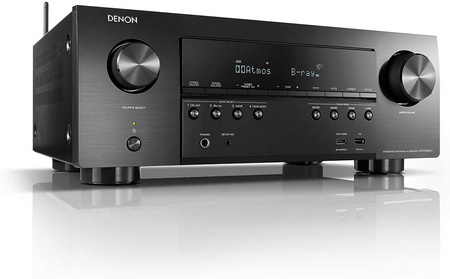
Denon makes a number of great 7.1/7.2 AV receivers. We’ve selected AVR-S950H but you should also check out the X line (AVR-X1600, AVR-X2600). The unit we chose has 8 HDMI inputs (7 on the back and one on the front), it features both Bluetooth and wi-fi, and it has multiroom capabilities.
 Things we like
Things we like
AVR-S950H comes with a remote, AUDYSEY MultEQ calibration mic, FM/AM antenna, Bluetooth/wi-fi antenna, manual, and a 3-year warranty.
The initial setup is smooth and simple. You have to follow the on-screen instructions and plug in the calibration mic. The unit will do the rest of the job.
S950H has an amazing number of connections. There are four connections on the front – headphone OUT, mic input, one HDMI IN, and one USB port.
All the other inputs/outputs are on the back. Most importantly, you have 7 HDMI inputs and two HDMI OUT ports (one of them supports ARC/eARC). All HDMI ports support HDCP 2.3, 4K/60Hz pass-through, as well as 3D video pass-through. AVR-S950H also has 2 component video inputs and one output, two composite inputs, and one composite output. When it comes to audio inputs, you have three digital inputs (optical x2, coaxial x1), 4 analog RCA inputs, and one phono input. Finally, the unit houses an Ethernet port, Bluetooth/wi-fi antenna connector, and AM/FM connectors.
When it comes to speaker outputs, you have 7 speaker terminals (5-way binding posts) and two subwoofer pre-outputs. The last two speaker terminals (surround back channels) are assignable so you can also connect your height speakers to those two terminals (you get to choose between 7.1/7.2 system and 5.1.2/5.2.2). You can also use these two channels as Zone 2 speaker outputs. The amplifier section can push 90W RMS per channel (all five channels driven, 0.08% THD, 20Hz-20kHz).
Apart from all the physical connections, AVR-S950H features AM and FM tuners, Bluetooth connectivity, and wi-fi connectivity. It also supports Airplay 2 and HEOS wireless streaming technology which makes it compatible with other HEOS equipment. S950H is compatible with voice assistants (Alexa, Josh AI, Google Assistant, Siri).
The receiver can decode all the most common Dolby and DTS surround soundtracks. That includes DTS:X, DTS Virtual:X, and Dolby Atmos.
 Things we don’t like
Things we don’t like
The only bad thing about this magnificent receiver is the included Denon AVR remote app. It’s not stable and crashes randomly.
6. Best 7.2 Surround Sound Amplifier Under $1,000 – Yamaha Aventage RX-A880
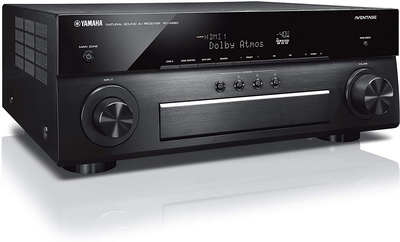
RX-A880 comes from the latest, most advanced, and most versatile line of Yamaha receivers called AVENTAGE. This is our favorite 7.2 AV receiver under $1,000.
 Things we like
Things we like
Like all Yamaha receivers, RX-A880 comes with the YPAO calibration mic, remote, detachable AM and FM antennas, and Bluetooth/wi-fi antennas.
RX-A880 has some features we haven’t seen on the previous cheaper receivers. For example, it has preamp power outputs for all the channels (including zone 2) and it also has dedicated zone 2 speaker terminals.
The front panel looks quite clean with only two dials (input select and volume) and 4 SCENE buttons (custom presets). In the middle, there’s a wide LCD display and a hidden compartment with 4 inputs (AUX input, headphone OUT, YPAO mic input, and a USB port).
The rest of the connections are on the rear panel. RX-A880 houses 7 HDMI inputs and two HDMI outputs (one of which is HDMI ARC). All HDMI ports support 4K/60Hz UHD and 3D video pass-through. They are all compliant with HDCP 2.2 and support Hybrid Log-Gamma, HDR10, and Dolby Vision.
RX-A880 also has one component and one composite video input, two optical audio inputs, two coax inputs, one phono input, and three analog RCA inputs. Finally, RX-A880 has an Ethernet port, AM/FM connectors, and an RS-232C port.
When it comes to speaker terminals, this unit has 9 of them, but only 7 can be powered at the same time. The last pair of binding posts is reserved for the Zone 2 that activates when the signal is sent to the Zone 2 speakers. However, since only 7 outputs are powered, if you have a 7.1/7.2 or 5.1.2/5.2.2 speaker system in your main zone, the system will be modified to 5.1/5.2 (the amplification for the surround back or height speakers will be redirected to the Zone 2). RX-A880 also has 2 subwoofer pre-outputs as well as preamp outputs for all the other channels, including two preamp outputs for the Zone 2 speakers. The rated power output is 100W RMS (two 8Ω channels, 0.06% THD across the audible spectrum).
Besides the physical connections, RX-A880 supports wireless connectivity (Bluetooth 4.1 and wi-fi). It also supports Airplay 2 and it works with Alexa. Finally, A880 supports MusicCast wireless technology, which makes it compatible with other MultiCast equipment. This allows you to make A880 a part of your multiroom system or to connect a pair of wireless MusicCast speakers and use them as wireless surround sound channels.
 Things we don’t like
Things we don’t like
The MusicCast app is buggy at times and needs some improvements. Also, the user interface doesn’t look very attractive.
7. Best Chromecast-Enabled 7.2 AV Receiver – Sony STR-DN1080
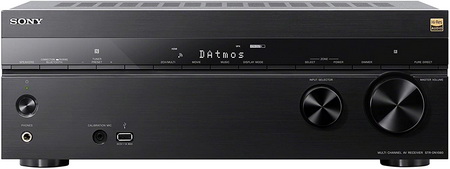
Chromecast support is not as common feature as Airplay, but some manufacturers have both. Sony, for example. In terms of features and performance, STR-DN1080 is quite similar to the previously reviewed Denon AVR-S950H, only not as versatile when it comes to physical connections.
 Things we like
Things we like
Sony STR-DN1080 comes with a DCAC calibration mic, remote, detachable radio antennas, and Bluetooth/wi-fi antenna.
The receiver allows you to connect more than 10 audio and video sources. The front panel houses only headphone output, calibration mic input, and a USB port. The rear panel houses 6 HDMI inputs and two outputs. All these inputs/outputs support 4K/60Hz and 3D pass-through. They are all compliant with the HDCP 2.2 and support HDR. According to the specs, the receiver doesn’t support Dolby Vision and HLG but some of the future firmware upgrades may include support for these standards.
Except for the HDMI inputs/outputs, STR-DN1080 has one coax and one optical audio input, 4 analog RCA audio inputs, three composite video inputs, and one composite output.
The receiver has 9 speaker terminals (7 of which are powered at the same time). Just like in the case of Yamaha RX-A880, you can choose whether you want to supply power to the Zone 2 speakers or to the surround back speakers (7.1 or 5.1 + Zone 2 speakers). The unit is compatible with 6-16Ω speakers. The advertised RMS power output is 100W per channel (two 6Ω channels, 0.09% THD across the audible spectrum).
STR-DN1080 can decode all Dolby and DTS formats (Atmos and DTS:X are included). It can even simulate surround sound when only two front speakers are connected (Virtual Surround PRO).
Just like other units on our list of best surround sound amplifiers for 7.1 systems, STR-DN1080 has many additional features. STR-DN1080 is one of the rare units in this price range that has Bluetooth with NFC and with LDAC support. Most other receivers support only the most basic Bluetooth codecs (SBC and AAC). Furthermore, STR-DN1080 features dual-band wi-fi connectivity, and it supports Chromecast and Airplay. It can work and be controlled with Google Home speakers and it can be a part of your multiroom system.
 Things we don’t like
Things we don’t like
STR-DN1080 doesn’t have phono inputs. Also, it’s not compatible with Alexa.
8. The Slimmest 7.2 Surround Sound Amplifier – Marantz NR1710

Like the previous Marantz receiver on our list of 8 best surround sound amplifiers for 5.1 & 7.1 systems, NR1710 comes from Marantz’s line of slim receivers. But this one is much more versatile and feature-rich.
 Things we like
Things we like
Marantz NR1710 looks exactly the same as previously reviewed NR1403 but has more connections. On the front, it has a headphone output, calibration mic input (the Audyssey MultEQ mic is included in the package), a USB port, and one HDMI input.
Like always, the majority of inputs/outputs are on the rear panel. Apart from that one on the front, NR1710 also has 7 HDMI inputs and one output on the back. All these inputs support 4K/60Hz and 3D pass-through. Naturally, all the ports support HDCP 2.3 and HDR10, HLG, and Dolby Vision.
When it comes to other video inputs/outputs, you have 2 component inputs and one component OUT, and 3 composite inputs and one composite OUT. As far as audio connections are concerned, there’s one optical, one coaxial, 3 analog inputs, and one phono input.
Recommended Reading :
- 7 Best All-in-One Stereo Systems With Turntables
- 7 Best Home Stereo Systems
- 8 Best Wireless TV Speakers For Hearing Impaired
NR1710 has 7 powered speaker outputs, two of which are assignable and can be used as Zone 2 channels. There are also two subwoofer pre-outputs as well as preamp outs for the front left and right channels and Zone 2 speakers. So, if you have a separate stereo amplifier, you can run the wires from the Zone 2 preamp channels to the stereo amp located in the Zone 2 and have a full 7.1 or 5.1.2 surround sound system in the main zone and two speakers in the zone 2. The advertised power output is the same as with NR1403 – 50W per channel (all 7 8Ω channels driven, 20Hz-20kHz, 0.08% THD)
The receiver can decode all DTS and Dolby formats, including DTS:X, DTS Virtual:X, DTS Neural:X, and Dolby Atmos.
NR1710 is much better than the NR1403 when it comes to additional features and advanced connectivity. While the NR1403 featured only Bluetooth, NR1710 features wi-fi connectivity, it supports Airplay 2 and works with Alexa. Also, like all Denon and Marantz AV receivers, it features HEOS wireless technology that gives it multiroom capabilities and makes it compatible with other HEOS wireless speakers, receivers, and soundbars.
 Things we don’t like
Things we don’t like
Marantz AVR Remote app offers the same kind of performance as the Denon AVR app – it’s buggy and crashes randomly.
This is the end of our list of 8 best surround sound amplifiers for 5.1 & 7.1 systems in 2024. Hopefully, you managed to find the perfect unit for your surround sound system. If you want to learn more about surround sound amplifiers and AV receivers, read our FAQs. For any additional info or advice, leave us a comment below.
FAQs
Q: What is better 5.1 or 7.1 surround sound?
A: If you have enough space and money, a bigger surround sound system is always a better option and gives you a more immersive movie-watching experience. However, in our opinion, the difference between 5.1 and 7.1 is not as big as the difference between 5.1 and 5.1.2 (or even better 5.2.4). So, if you get to choose between 7.1 and 5.1.2, go for 5.1.2.
Q: What to pay attention to when looking for a surround sound amplifier for 5.1 & 7.1 systems?
A: Looking for the right surround sound amplifier (AV receiver) is actually not that hard. These devices may look scary or confusing, but once you understand the most important characteristics, it gets much easier.
First, you must set the budget (and be reasonable – you must know what to expect at a certain price point). If you don’t really know what to expect at a certain price point, this can be your last step. Second, look for an amplifier/receiver with the right number of inputs (HDMI, optical, coaxial, component, composite) and outputs (HDMI ARC output, preamp-outputs, subwoofer outputs). HDMI inputs should support all the standards that your TV and other audio/video sources support. So, if your TV and Blu-ray player are 4K capable, look for a receiver with HDMI 2.0 ports and with 4K pass-through.
Third, an amplifier/receiver must have enough speaker terminals to connect all the home theater speakers and has to output enough power to drive them all.
Once you find all these things, you can move onto the less important but very convenient features (like Bluetooth, wi-fi, multi-zone, multi-room, voice control, etc.).
Q: Can you use a 7.1 receiver with a 5.1 speaker system?
A: Yes, of course you can. Any receiver with a higher number of channels can be used with smaller home theater systems. So, you can also use 7.2, 9.2, 11.2, or 13.2 receiver with a 5.1 speaker system. However, receivers with a higher number of speaker outputs are usually much pricier and it’s a bit meaningless using a 13.2 receiver for a 5.1 system, especially if you’re not planning on upgrading the speaker system in the future.
Q: What is the best surround sound amplifier for 5.1 & 7.1 Systems?
A: There can’t be only one answer to this question. There are simply too many great models and their prices and features can vary. That’s why we made a selection of 8 best surround sound amplifiers for 5.1 & 7.1 systems in 2024. You just have to scroll up, check out our suggestions, and find the perfect unit for your needs.
Q: Is 7.1 better than Atmos?
A: Dolby Atmos adds another dimension (height dimension) to the surround sound making it more life-like. 7.1 surround sound is pretty great but doesn’t sound as good as Dolby Atmos. It simply lacks height effects. The only advantage of a 7.1 surround sound is that more movies have 7.1 tracks. Dolby Atmos is still not as popular as 7.1.
Q: What is the difference between 7.1 and 7.2 surround sound?
A: The difference is in the additional subwoofer. 7.1 surround sound system has only one sub, while the 7.2 surround sound system has two.

Hello, my name is James Longman.
I’m a writer and editor at AudioReputation. I disassembled my first portable AM/FM radio when I was only 8. At the age of 11, I burned the circuit board on my old boombox cassette player. I’m not going to explain how but it was reckless and stupid.
Since then, I have become much more careful around radios, boomboxes, and other audio devices (at least, I like to think so) but I have never lost the passion for audio equipment. Throughout 20 years of my professional career, I’ve been working for various audio equipment manufacturers and even started building speakers on my own in my little workshop.
I love the work we do here at AudioReputation. Testing, comparing, and evaluating all kinds of audio devices (speakers, soundbars, headphones, home theater systems, etc.) is something I truly enjoy. I try to be unbiased and give you my honest opinion on every piece of equipment I test. Still, you should take my reviews with a pinch of salt and always be just a little bit skeptical. The fact that I liked some speaker or soundbar doesn’t mean that you are going to love it. If you have the opportunity, you should test it/hear it before buying it.


Hi Mr. James,
I currently have a Yamaha receiver with hardwired room speakers and two wireless Yamaha speakers in other rooms, using Yamaha’s MusicCast system. The MusicCast system is operated from their app on a smart phone. That set up is clunky and loses connection or is occasionally erratic. I’m trying to find a system to replace the current one, preferably one that doesn’t use an app as control.
Any suggestions?
Hi, Terry
If you want to keep your hardwired room speakers and just replace the receiver and/or wireless speakers, we’re afraid that you have a very limited number of options. If your receiver supports Airplay (preferably Airplay 2), you could try replacing your Yamaha wireless speakers with some Airplay-compatible speakers (Apple HomePod, Sonos speakers, Naim Mu-So wireless speakers, Audio Pro, JBL Link, Linn wireless speakers with Airplay support, B&W wireless speakers with Airplay support, Libratone Zipp 2, BlueSound wireless speakers, etc.). That way, you won’t have to use the MusicCast app for wireless streaming.
The second option is replacing both – your receiver and your wireless speakers, and moving from MusicCast ecosystem to some other ecosystem. For example, you could try some Denon or Marantz receiver with HEOS support, and some HEOS wireless speakers.
If you’re willing to replace your hardwired speakers, you can also buy some wireless surround sound system with multiroom capabilities and then add some compatible wireless speakers. SONOS would be our top suggestion (because of great reliability and ease of use), but you could also try Bose (build wireless surround system around Bose Soundbar 500 or Soundbar 700, and then use some of the compatible Bose wireless speakers for multiroomm streaming).
Hope this helps
Your AudioReputation Team